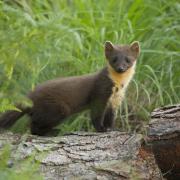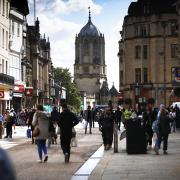On hot sunny days there’s nothing more refreshing than spending time close to water. Gloucestershire Wildlife Trust takes a long look at some of the beautiful insects to be found in and around some of their nature reserves.
Dragonflies are the aerodynamic acrobats of the insect world, thrilling audiences with sudden changes of direction and even backwards manoeuvres as they zip through the air.
Yet the appearance of these elegant fliers is actually the final flourish of a far longer existence, much of which is spent scouring the floors of ponds, rivers and streams in search of food to satisfy their voracious appetites.
The switch from silt searcher to airborne ace occurs during warm days in spring and summer, when mature larvae use their six legs to crawl along reeds and other aquatic plants into the sunshine. Here the slender, winged adult form of the insect emerges and takes to the air for a few short weeks to eat, mate and lay eggs.

Dragonflies and closely-related damselflies are a familiar sight around wet spots, with several different species seen in and around Gloucestershire Wildlife Trust nature reserves such as Coombe Hill Meadows near Tewkesbury, Whelford Pools near the Cotswold Water Park and Woorgreens in the Forest of Dean.
In fact, the types seen in various locations tell ecologists a lot about the condition of these bodies of water.
“They’re good indicator species,” explains a GWT expert.
“They provide a lot of information about the water body: some species such as the broad-bodied chaser and brown hawker thrive in quite dirty water; water that’s rich in nutrients. Water like this causes algae growth.
“Most dragonflies don’t like that kind of water, however, and a good diversity indicates a healthy environment.”
Another reason why these insects are important is their diet, which contributes to keeping the likes of mosquitoes and midges in check.

“Both larvae and dragonflies are voracious predators,” the expert adds. “The larvae will eat anything, including small fish if they can catch them, and things like fresh water shrimps.
“At the other end of the food chain is the hobby, a type of falcon especially evolved to eat dragonflies, while damselflies are eaten by wagtails, flycatchers and other small birds.”
The largest species of dragonfly in the UK is the emperor, the males of which are bright blue while the females are a greener colour and can sometimes be seen laying their eggs on water plants.
Southern hawkers are large and inquisitive and will often fly right up to people. The males are dark with blue and green markings while the females are brown and green.
Four-spotted chasers are easily recognised by the two dark spots on the leading edge of each wing and are common in Gloucestershire. They spend a lot of time flying over water for insect prey or to mark out their territories.
The best time to see dragonflies is between 10am and 2pm during sunny days, with smaller ponds preferred to large lakes.

Cotswold Great – Emperor dragonfly
At Whelford Pools nature reserve, near the Cotswold Water Park, clouds of dragonflies and damselflies dart over the waters in the summer months. One dragonfly species that lives here is the emperor dragonfly, a large and bright blue dragonfly that flies until September.
One of the largest dragonfly species in Europe, the emperor is rarely found away from water, where the females lay their eggs in floating pondweed. These impressive creatures fly up high on their hunts for insect-prey, and dive down to catch them mid-air. They sometimes even eat on the wing!
The males are very territorial and will chase away any intruders that get too close, sometimes even fighting rival males for top spot!

Four ways to tell apart dragonflies and damselflies
Eyes – Dragonflies have much larger eyes than damselflies. The eyes of a damselfly are large but there is always a gap between them.
Body shape – Dragonflies have bulkier bodies than damselflies, which are almost twig-like in comparison.
Wing shape - Dragonflies have hind wings that tend to be larger than the front wings and that broaden at the base. Damselflies have sets of wings that are the same size and that taper down as they join the body.
Wings at rest - When resting, dragonflies hold their wings out at right angles to their bodies. Damselflies fold their wings up and hold them together along their backs.
Did you know?
Some of the largest insect fossils that have been found are dragonfly fossils from around 280 million years ago! Dragonflies used to be much bigger in the past, likely due to the higher oxygen levels in the atmosphere than at present.



























